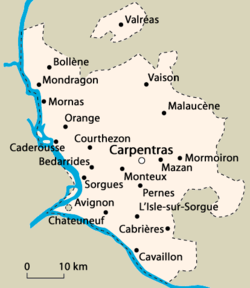Comtat Venaissin
| Comtat Venaissin | ||||||||||
|
Comtat Venaissin (fr) Coumtat Venessin (prov) Pagus Vendascinus Venuxini Comitatus (la) |
||||||||||
| Papal enclave | ||||||||||
|
||||||||||
|
||||||||||
| Capital | Venasque, Carpentras | |||||||||
| Languages | Provençal | |||||||||
| Religion | Catholic | |||||||||
| Government | Monarchy | |||||||||
| Historical era | Middle Ages | |||||||||
| • | Death of Alfonso, Count of Provence |
21 August 1271 |
||||||||
| • | Acquired by Papacy | 1274 | ||||||||
| • | Capital moved to Carpentras |
1320 |
||||||||
| • |
Avignon sold by Joan, Countess of Provence |
1348 |
||||||||
| • | French occupation | 1663, 1668, 1768–74 | ||||||||
| • | Incorporated into France by plebiscite |
14 September 1791 |
||||||||
| Currency | Roman scudo | |||||||||
|
||||||||||
| Today part of |
|
|||||||||
The Comtat Venaissin (Provençal: lou Coumtat Venessin, Mistralian norm: la Coumtat, classical norm: lo Comtat Venaicin; "County of Venaissin"), often called the Comtat for short, was a part of the Papal States in what is now the Provence-Alpes-Côte d'Azur region of France.
The entire region was an enclave within the Kingdom of France, comprising the area around the city of Avignon (itself always a separate comtat) roughly between the Rhône, the Durance and Mont Ventoux, and a small exclave located to the north around the town of Valréas bought by Pope John XXII. The Comtat also bordered (and mostly surrounded) the Principality of Orange. The region is still known informally as the Comtat Venaissin, although this no longer has any political meaning.
In 1096, the Comtat was part of the Margraviate of Provence that was inherited by Raymond IV, Count of Toulouse from William Bertrand of Provence. These lands in the Holy Roman Empire belonged to Joan, Countess of Toulouse, and her husband, Alphonse, Count of Poitiers. Alphonse bequeathed it to the Holy See on his death in 1271. Since this happened during an interregnum, there was no Holy Roman Emperor to protect Joan's rights.
...
Wikipedia




